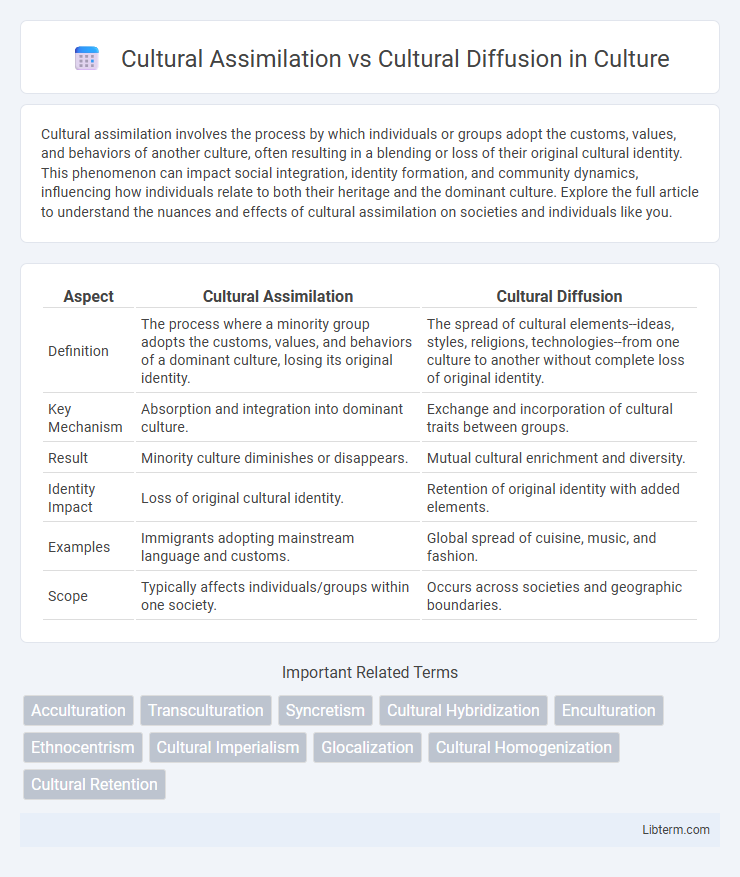Cultural assimilation involves the process by which individuals or groups adopt the customs, values, and behaviors of another culture, often resulting in a blending or loss of their original cultural identity. This phenomenon can impact social integration, identity formation, and community dynamics, influencing how individuals relate to both their heritage and the dominant culture. Explore the full article to understand the nuances and effects of cultural assimilation on societies and individuals like you.
Table of Comparison
| Aspect | Cultural Assimilation | Cultural Diffusion |
|---|---|---|
| Definition | The process where a minority group adopts the customs, values, and behaviors of a dominant culture, losing its original identity. | The spread of cultural elements--ideas, styles, religions, technologies--from one culture to another without complete loss of original identity. |
| Key Mechanism | Absorption and integration into dominant culture. | Exchange and incorporation of cultural traits between groups. |
| Result | Minority culture diminishes or disappears. | Mutual cultural enrichment and diversity. |
| Identity Impact | Loss of original cultural identity. | Retention of original identity with added elements. |
| Examples | Immigrants adopting mainstream language and customs. | Global spread of cuisine, music, and fashion. |
| Scope | Typically affects individuals/groups within one society. | Occurs across societies and geographic boundaries. |
Introduction to Cultural Assimilation and Cultural Diffusion
Cultural assimilation involves the process by which a minority group gradually adopts the customs, values, and behaviors of a dominant culture, often resulting in the loss of the original cultural identity. Cultural diffusion refers to the spread of cultural elements such as ideas, styles, religions, and technologies between societies, leading to shared traditions and innovations without necessarily erasing distinct cultural identities. Understanding the dynamics of assimilation and diffusion is essential for analyzing the evolution and interaction of societies throughout history.
Defining Cultural Assimilation
Cultural assimilation refers to the process by which individuals or groups adopt the cultural traits, norms, and behaviors of another, often dominant, culture, leading to the loss or modification of their original cultural identity. This phenomenon typically involves changes in language, dress, customs, and social practices to conform with the prevailing cultural environment. Unlike cultural diffusion, which involves the exchange and blending of cultural elements between groups, assimilation results in the absorption and potential erasure of distinct cultural differences.
Understanding Cultural Diffusion
Cultural diffusion involves the spread of cultural elements such as language, customs, and technology from one society to another, enhancing cross-cultural interactions without fully erasing original cultural identities. It facilitates the exchange and adaptation of cultural traits, promoting diversity and innovation while maintaining a balance between cultural preservation and change. Understanding cultural diffusion is crucial for analyzing how globalization impacts cultural landscapes by enabling coexistence and blending of cultures rather than complete assimilation.
Key Differences Between Assimilation and Diffusion
Cultural assimilation involves one group fully absorbing another's cultural traits, leading to the loss of original identities, while cultural diffusion refers to the spread of cultural elements between societies without complete integration. Assimilation results in a dominant culture overshadowing minority cultures, whereas diffusion promotes diversity by blending and sharing customs, ideas, and innovations. The key difference lies in assimilation's emphasis on conformity and homogenization, contrasting with diffusion's emphasis on exchange and coexistence of multiple cultural influences.
Historical Examples of Cultural Assimilation
Historical examples of cultural assimilation include the Roman Empire's integration of conquered peoples through language adoption and legal systems, causing the gradual loss of indigenous identities. The forced assimilation of Native Americans in the 19th century United States, notably through boarding schools, aimed to eradicate tribal languages and customs in favor of Euro-American culture. Japanese assimilation policies in Korea during the early 20th century imposed language, education, and religious changes to suppress Korean heritage and enforce Japanese identity.
Significant Cases of Cultural Diffusion
The Silk Road exemplifies significant cultural diffusion, facilitating the exchange of goods, ideas, and technologies between East and West for centuries. The spread of Buddhism from India to East Asia via trade routes highlights how cultural diffusion shapes religious practices and societal values across regions. The Columbian Exchange dramatically transformed agriculture, cuisine, and populations worldwide by transferring crops, animals, and cultural elements between the Americas and Europe.
Impact on Societies and Communities
Cultural assimilation often leads to the dominance of a single culture, resulting in the erosion of indigenous customs, languages, and identities within societies. In contrast, cultural diffusion promotes the exchange and integration of diverse cultural practices, enriching communities through hybrid traditions and fostering social cohesion. The impact of assimilation can suppress minority groups, while diffusion tends to enhance multiculturalism and adaptability in increasingly globalized societies.
Challenges and Controversies
Cultural assimilation often faces challenges such as loss of identity, resistance from minority groups, and social marginalization, while cultural diffusion raises controversies related to cultural appropriation, dilution of traditional values, and unequal power dynamics. The tension between preserving cultural heritage and adapting to dominant societal norms fuels ongoing debates among scholars and communities. These challenges underscore the complexity of navigating cultural integration in diverse societies.
Modern Implications in a Globalized World
Cultural assimilation often results in the erosion of minority traditions as dominant cultures impose their values, impacting social cohesion and identity in multicultural societies. Cultural diffusion promotes the exchange and blending of ideas, technologies, and customs, fostering innovation and cross-cultural understanding in globalized economies. These processes shape international relations, migration policies, and global marketing strategies by influencing how cultures adapt or resist external influences.
Conclusion: Navigating Cultural Change
Navigating cultural change requires understanding the distinct impacts of cultural assimilation and cultural diffusion on societies. Cultural assimilation often leads to the dominance of one culture, reducing diversity, while cultural diffusion promotes the exchange and blending of cultural traits, fostering multiculturalism. Effective cultural integration balances respect for original cultural identities with openness to new influences, ensuring social cohesion and cultural enrichment.
Cultural Assimilation Infographic

 libterm.com
libterm.com